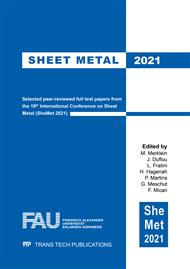p.242
p.250
p.258
p.269
p.277
p.285
p.294
p.303
p.309
Determination of the Biaxial Anisotropy Coefficient Using a Single Layer Sheet Metal Compression Test
Abstract:
Numerical process design leads to cost and time savings in sheet metal forming processes. Therefore, a modeling of the material behavior is required to map the flow properties of sheet metal. For the identification of current yield criteria, the yield strength and the hardening behavior as well as the Lankford coefficients are taken into account. By considering the anisotropy as a function of rolling direction and stress state, the prediction quality of anisotropic materials is improved by a more accurate modeling of the yield locus curve. According to the current state of the art, the layer compression test is used to determine the corresponding Lankford coefficient for the biaxial tensile stress state. However, the test setup and the test procedure is quite challenging compared to other tests for the material characterization. Due to this, the test is only of limited suitability if only the Lankford coefficient has to be determined. In this contribution, a simplified test is presented. It is a reduction of the layer compression test to one single sheet layer. So the Lankford coefficient for the biaxial tensile stress state can be analyzed with a significantly lower test effort. The results prove the applicability of the proposed test for an easy and time efficient characterization of the biaxial Lankford coefficient.
Info:
Periodical:
Pages:
303-308
Citation:
Online since:
April 2021
Authors:
Keywords:
Price:
Сopyright:
© 2021 Trans Tech Publications Ltd. All Rights Reserved
Share:
Citation:


